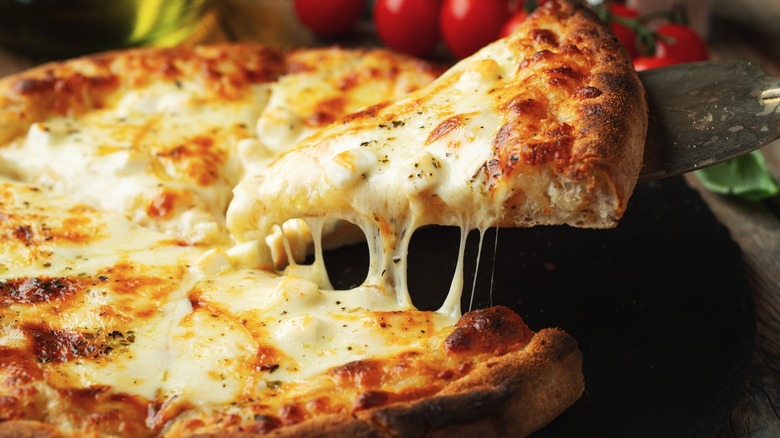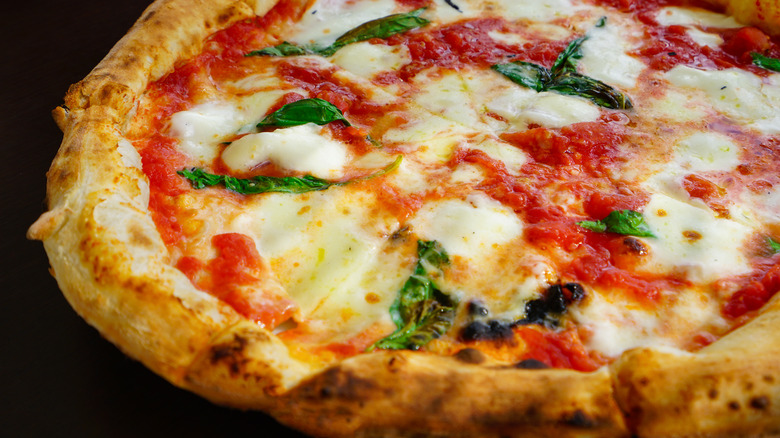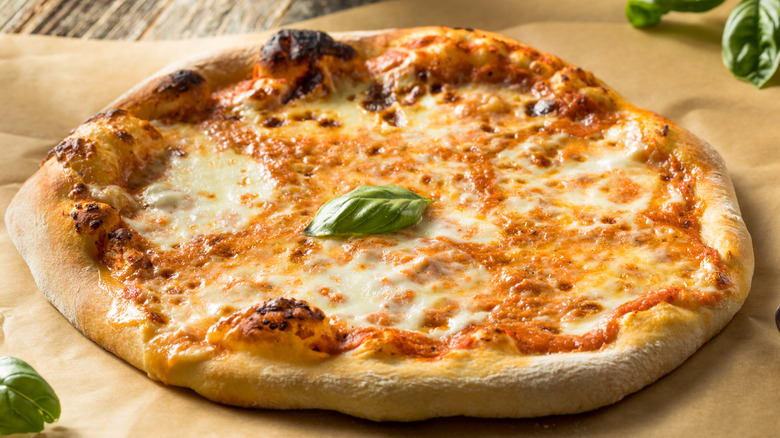Why It's Important To Choose The Right Cheese When Making Pizza
Nothing embodies the cultural melting pot that is the United States more than its cuisine. While "American cuisine" is loosely defined as apple pie, hamburgers, and salads, the European, African, Latinx, and Asian immigrants who settled here and continue to do so, make up our food cravings, date night reservations, neighborhood haunts, and delivery options. In a world of instant information, new cuisines quickly become American favorites. Data analyzed from hundreds of thousands of Grub Hub delivery users uncovered the foods we ordered repeatedly in 2022, revealing Americans' favorite foods include gyoza, pad Thai, and tikka masala. Our diverse diet consists of cuisine that originated far beyond our borders, with Italian, Chinese, Japanese, and Mexican food topping the list (via Reader's Digest).
In a land filled with so many options, according to USA Today, Americans' favorite food is pizza. There are more than 75,000 pizzerias across the U.S. While the classic cheese pizza is a classic for a reason, our favorite pizza topping vary depending on your area code. Pepperoni pizza reigns supreme in most states, while New Mexicans and Arizonans prefer anchovies, per How To Cook.
With so few ingredients and a quick cooking time, quality remains imperative. Details, like taking the time to ferment the dough, making an acidic yet balanced pizza sauce, and choosing the right cheese when making pizza, are critical to the taste of your pizza. So, before you order your next delivery or preheat your portable pizza oven, think about your cheese options.
Fresh mozzarella
While pizza differs regionally in the U.S. — from Chicago-style deep dish pizza, to Rhode Island's grilled pizza, New Haven, Connecticut's unique "apizza" — most people agree mozzarella is the best cheese to use on pizza. Taking a scientific approach, Food Network examined factors like elasticity, meltability, oil and moisture content, and whether it can brown and blister — a must to achieve the Maillard Reaction. After all, generally speaking, cheese is delicious, but each performs and looks differently when cooked at 900 degrees. Beating out cheddar, Colby, Edam, Emmental, Gruyere, and provolone, mozzarella retained its status as the go-to pizza cheese.
Prized for its mild, sweet taste and ability to melt, there are several types of mozzarella, each with different textures, strengths, and flavors. This cow's milk cheese from southern Italy can be divided into two categories, fresh and low-moisture, then further divided into subcategories.
Fresh mozzarella is stored in water and is soft enough to tear. Fresh mozzarella is available in different shapes and sizes, from tiny pearls or "perline" to large balls called "ovaline" and braids. Fiore di latte, the formal name for fresh mozzarella, is packed in water or marinated in oil; bufala is made from water buffalo milk from the Campania region of Italy; stracciatella is made from scraps or "rags" of mozzarella that are mixed with cream to create a spreadable mozzarella; and burrata is a shell of semi-firm mozzarella with a creamy center reminiscent of ricotta that oozes when sliced, per Allrecipes.
Low-moisture mozzarella
Low-moisture mozzarella is firmer and drier than fresh. It is often shredded and used for the stringy, pull-apart texture wanted for dishes like New York-style pizza, baked ziti, and chicken parmesan. Low-moisture mozzarella is sold as part-skim and whole milk. While whole milk is creamier, both options brown well and distribute evenly. Low-moisture cheese is sold pre-shredded, which is convenient and timesaving; however, according to America's Test Kitchen, it's filled with additives like cellulose and cornstarch, which affect the mouthfeel, meltability, and taste. You also pay a premium for the convenience, so it's better to buy a block, roll up your sleeves, and shred the cheese yourself.
So, which is the best cheese to use? Look to the OG. Naples, Italy, the birthplace of pizza, and its people are culturally tied together. The cultural arm of the United Nations, UNESCO, elevated Neopolitan pizza to "intangible cultural heritage" status, protecting the art and ingredients that make up its prized pizza. Authentic Neapolitan pizza must adhere to rigorous standards outlined by Associazione Verace Pizza Napoletana (VPN), which includes the type of wood-fired oven to use, which ingredients compose the pizza, and what size the pie must be. According to the VPN, only sliced buffalo mozzarella or strips of fiore di latte can be used on its pizza.
Of course, food is about personal preferences, so choose what you like best or mix the classic mozzarella with a more pungent cheese to make a gourmet pizza all your own.


